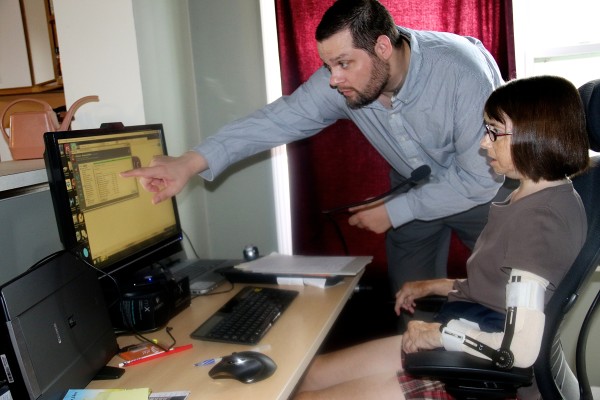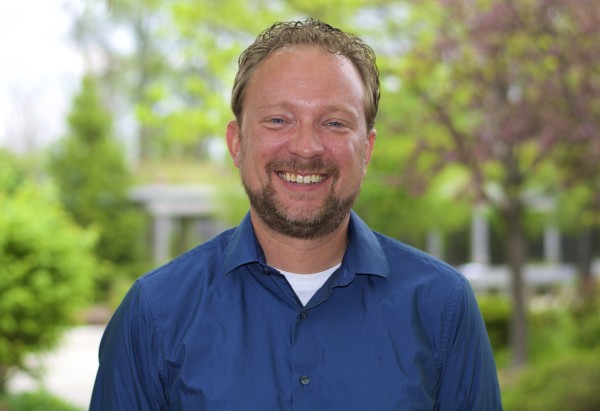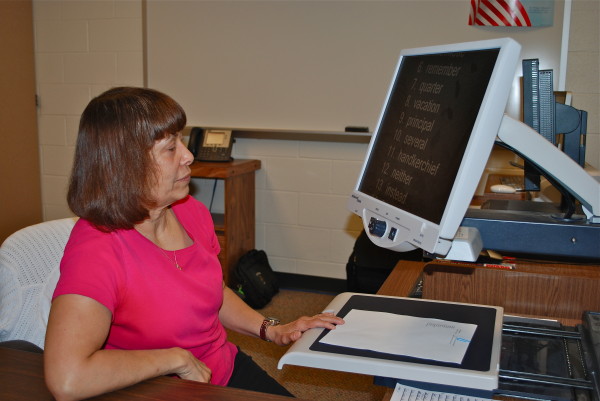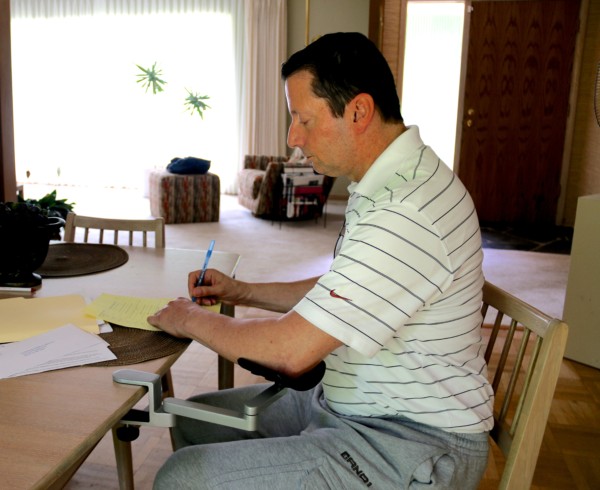Writer: Tiffany Whisner, Coles Marketing
 ATP. Assistive Technology Professional. This certification is more than just three letters after your name. Just like all educational degrees, licensures, certifications and awards, ATP means something — not just to the person who receives it, but to consumers with disabilities and the assistive technology community.
ATP. Assistive Technology Professional. This certification is more than just three letters after your name. Just like all educational degrees, licensures, certifications and awards, ATP means something — not just to the person who receives it, but to consumers with disabilities and the assistive technology community.
And like most credentials, a lot of hard work and studying goes into gaining them — they demonstrate competence, expertise and an emphasis on personal development.
Increasing access to tech solutions
“The ATP certification recognizes professionals who have achieved an internationally-accepted standard of knowledge in assistive technology,” said Melissa Campbell, manager of certification and education at the Rehabilitation Engineering and Assistive Technology Society of North America (RESNA).
 RESNA is the premier professional organization dedicated to promoting the health and well-being of people with disabilities through increasing access to technology solutions. RESNA offers certification, continuing education and other professional development opportunities to the assistive technology (AT) professional community at large.
RESNA is the premier professional organization dedicated to promoting the health and well-being of people with disabilities through increasing access to technology solutions. RESNA offers certification, continuing education and other professional development opportunities to the assistive technology (AT) professional community at large.
The ATP certification is one of two certifications RESNA offers, and it recognizes proficiency in analyzing the needs of consumers with disabilities, assisting in the selection of appropriate AT for the consumer’s needs and providing training in the use of the selected device or devices.
“Having the ATP certification shows our consumers and clients we are focused on a human-centric model of treatment and care,” said Josh Anderson, manager of clinical assistive technology at Easter Seals Crossroads.
 Anderson is one of three individuals on staff at the INDATA Project at Easter Seals Crossroads who just recently received his ATP certification. And it was an important step for him, both personally and professionally.
Anderson is one of three individuals on staff at the INDATA Project at Easter Seals Crossroads who just recently received his ATP certification. And it was an important step for him, both personally and professionally.
“Getting certified confirms the person has more in-depth and specific knowledge about various AT topics and can not only assist consumers with disabilities in clarifying goals and possible future needs but also assesses the details of the individual’s circumstance and the impact of AT devices in that particular situation.”
Connection through credentials
With his Bachelor of Science in public affairs management, Anderson began working at Easter Seals Crossroads in 2011 as a job coach in the employment services division.
 “I actually began to learn more about assistive technology through serving as a job coach,” Anderson said. “I learned about different devices and technology solutions as I helped individuals with job placement and getting set up in their job environments. I worked with them to use assistive technology to overcome challenges in the workplace and help them learn how certain devices could help them in their jobs. Working with those tools really piqued my interest, and I wanted to learn more.”
“I actually began to learn more about assistive technology through serving as a job coach,” Anderson said. “I learned about different devices and technology solutions as I helped individuals with job placement and getting set up in their job environments. I worked with them to use assistive technology to overcome challenges in the workplace and help them learn how certain devices could help them in their jobs. Working with those tools really piqued my interest, and I wanted to learn more.”
When a position in the assistive technology department opened up, Anderson immediately applied. He was working as the clinical assistive technology coordinator at Easter Seals Crossroads and was recently promoted to the manager of clinical assistive technology.
 “We work with folks from all walks of life with all kinds of challenges and disabilities,” he said. “Most of them have a goal they want to accomplish or a barrier they want to overcome, whether it is at home, work or in their education. Some have had a disability for a long time, and others have had an accident or illness. It is my mission to be the best I can be for each individual and help them figure out how to achieve their goals and live to their greatest potential.”
“We work with folks from all walks of life with all kinds of challenges and disabilities,” he said. “Most of them have a goal they want to accomplish or a barrier they want to overcome, whether it is at home, work or in their education. Some have had a disability for a long time, and others have had an accident or illness. It is my mission to be the best I can be for each individual and help them figure out how to achieve their goals and live to their greatest potential.”
To Anderson, being the best he can be meant going after the ATP certification. And one of his mentors and leaders at Easter Seals Crossroads showed him what it meant to have the certification.
Wade Wingler is the vice president of technology and information at Easter Seals Crossroads — and the first person in Indiana to receive the ATP certification.
“I have met a lot of people who get into the field of assistive technology for many reasons,” Wingler said. “Most are well-intentioned and passionate. Sometimes a service provider has skills within a limited scope and doesn’t necessarily understand the broader implications of how AT fits into the environment and the life of the AT user. I was looking for a way to demonstrate I understood AT from a wide perspective and that I had a significant amount of experience. The ATP exam was, and remains, one of the best ways to demonstrate knowledge and experience. I’m proud of my ATP credential and even more proud of our robust team of ATP-credentialed professionals.”
 That team includes Wingler and Anderson along with Director of Assistive Technology Brian Norton, AT Specialist Craig Burns, Senior AT Specialist Mark Stewart and AT Specialist David Frye.
That team includes Wingler and Anderson along with Director of Assistive Technology Brian Norton, AT Specialist Craig Burns, Senior AT Specialist Mark Stewart and AT Specialist David Frye.
“More than four thousand individuals currently hold the ATP certification,” Campbell said. “The number of certifications continues to increase as employers, such as private companies and school districts, use the certification to help make decisions about hiring and promoting individuals who work in assistive technology service provision.”
To get certified, candidates must meet both the educational and work experience requirements — then pass a written exam.
“It was by far one of the hardest tests I’ve ever taken,” Anderson said. “I studied for it more than I have any other, and even after I finally submitted the test online, I still sat there and held my head in my hands. It was pretty nerve-wracking.”
Become an expert and share your knowledge
Two hundred multiple choice questions. Four hours to complete the exam. It’s enough to make anyone a bit nervous.
The exam is administrated via computer at various test centers around the world. It is preceded by a 10-minute tutorial providing instructions on how to navigate through the exam.
“I hadn’t been through anything like that before,” Anderson said. “It was basic multiple choice, but you can mark a question if you’re not sure of the answer and come back to it later. On the first time through the questions, I had marked about half the questions I wanted to go back to. That was me being overly cautious, but I just really wanted to take my time.”
He had a book to study from and also turned the test information into flashcards and other study materials. He even used an AT device to help him study.
 “I was traveling a lot for my job, so I used some text-to-speech software to turn my flashcards and other written materials into audio files I downloaded onto my phone and could listen to while driving. That way I was able to use both visual and auditory learning to help review all the information.”
“I was traveling a lot for my job, so I used some text-to-speech software to turn my flashcards and other written materials into audio files I downloaded onto my phone and could listen to while driving. That way I was able to use both visual and auditory learning to help review all the information.”
Using AT to study for an AT exam — seems pretty appropriate.
“As with any test, you can totally psyche yourself out,” Anderson said. “You have to take your time, as wording can really trip you up sometimes. When it comes to test taking, your nerves can just take over. I had to remind myself I knew the content and had done a lot of work to prepare.”
The exam covered the following: assessment of need; development of intervention strategies; implementation of intervention; evaluation of intervention; and professional conduct.
 “Many of the questions covered the AT job culture and were situational, like assessing your client’s needs and developing a plan to use assistive technology to help,” he said. “Often there is more than one right answer when evaluating a situation, so you have to look at other variables like the cost of an AT device and what path will supply the greatest benefit to the consumer.”
“Many of the questions covered the AT job culture and were situational, like assessing your client’s needs and developing a plan to use assistive technology to help,” he said. “Often there is more than one right answer when evaluating a situation, so you have to look at other variables like the cost of an AT device and what path will supply the greatest benefit to the consumer.”
There were questions that focused on the Americans with Disabilities Act (ADA) and other laws and legislation as well as those applying RESNA’s Code of Ethics and Standards of Practice.
“I was pretty nervous to begin with,” Anderson said. “But when I finally pressed the send button to submit my answers, I couldn’t tell if I was feeling panic or relief.” That’s because you receive instant feedback — a preliminary pass or fail — as soon as you submit. Candidates receive their official score report a few weeks later.
“The preliminary grade is pretty accurate though,” Anderson said. And although he received a preliminary pass, as did coworkers Burns and Frye, there was one very telling way Anderson found for confirmation.
“Brian (Norton) told me to check the RESNA website,” he said. “There is a place where you can search for a certified AT professional, and I kept checking the website every day for my name.”
Today, his name is there — certified until July 2018, when he has to get re-certified. That keeps all individuals on their toes and up to date on the most recent AT skills and RESNA standards.
“You have to continue your education through various courses and webinars and provide those details to RESNA every year. Otherwise, you have to take another written exam. Let’s definitely hope I don’t have to do that,” Anderson said with a laugh.
Professional value, personal worth
 The ATP shows the public — from consumers to funding and referral sources — that an individual or organization has expertise in assistive technology. It sets you apart but also shows you are part of a community of people and professionals who understand the importance of having advanced knowledge in technology solutions for individuals with disabilities.
The ATP shows the public — from consumers to funding and referral sources — that an individual or organization has expertise in assistive technology. It sets you apart but also shows you are part of a community of people and professionals who understand the importance of having advanced knowledge in technology solutions for individuals with disabilities.
“For me it was even more about personal development,” Anderson said. “I wanted to be better at my job. I want to make sure I am providing the best services I can based on the best methods and education offered in the AT industry. We hold people’s futures in our hands — and I don’t take that for granted.”
A growing number of exam candidates and pass rates each year demonstrates the training opportunities within the AT community are increasing, and the world is learning more about the importance of assistive technology to people with disabilities.
 “I love my job,” Anderson said. “It makes me happy to make others happy by helping them. No person or disability is the same, and no AT device is the same to use as a solution. I work with some of the smartest people in the world. They are a wealth of knowledge, and we all have the same goal — giving the absolute best service we can to help people with disabilities overcome the obstacles in front of them and live a happier and more productive life as a result.”
“I love my job,” Anderson said. “It makes me happy to make others happy by helping them. No person or disability is the same, and no AT device is the same to use as a solution. I work with some of the smartest people in the world. They are a wealth of knowledge, and we all have the same goal — giving the absolute best service we can to help people with disabilities overcome the obstacles in front of them and live a happier and more productive life as a result.”
